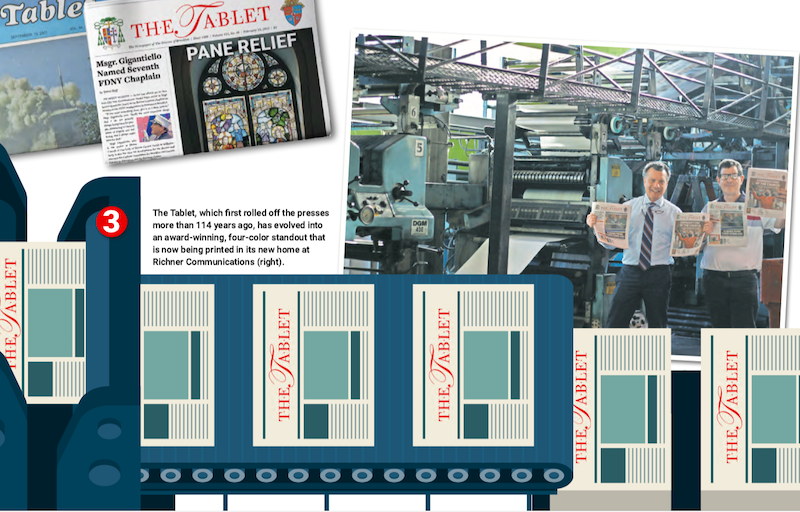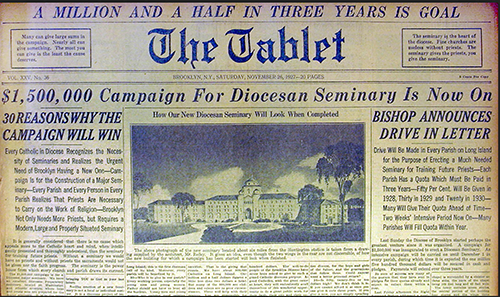
A Pressing Matter
GARDEN CITY, New York — Readers of the printed version of The Tablet may have noticed a few changes. Color and photo reproduction is considerably higher quality, and delivery is faster.
The improvements come after Richner Communications in Garden City, New York, began printing and distributing the paper on Feb. 15.
“The colors are more vibrant and true, the photos are crisper, and the page size has increased slightly, allowing for more news to fit,” said Vito Formica, executive director of news content and development for DeSales Media Group, the ministry that produces the newspaper for the Diocese of Brooklyn.
Stuart Richner, CEO of Richner Communications, said that he is proud to be printing The Tablet because of how critical it is to let different interest groups know that they have a voice within their communities.
“The Tablet certainly does that by serving the Catholic community in Brooklyn and Queens,” Richner said.
The Diocese of Brooklyn’s award-winning weekly newspaper has been in print since 1908 and has a heavy readership in the New York metro area, as well as across the United States.

The Tablet also publishes the Spanish-language newspaper Nuestra Voz, as well as Tablet Jr, a monthly supplement written and produced by and for Catholic school children in the diocese. It’s a legacy that Formica and his team take seriously and seek to preserve.
DeSales Media Group CEO Bill Maier added that experiencing the story of the diocese and the faith unfold on the pages of The Tablet each week is more than just a century-old tradition, but vital for the Church to continue to thrive, especially in today’s crowded media landscape.
“The Tablet beautifully reflects the richness of faith in the Catholic communities in Brooklyn, Queens, and everywhere else it reaches,” Maier said. “We strive for excellence always in our mis- sion, including the quality of the printing and the reliability of the distribution.”
However, over time, Formica said that quality-control issues in the printing of the newspaper, as well as problems with delivery, started to become an issue that needed to be addressed.
“Presentation, delivery, and customer service is a big part of the overall picture. That’s why we decided to make this change,” he added.
Richner Communications prints hundreds of publications a week — everything from daily publications to monthly and quarterly journals, and the company does it using local labor.
“We understand the importance of producing quality content and reproduction and that affects whether readers would want to pick up the paper, or an advertiser would want to advertise in the paper,” Richer said.
JoAnn DiNapoli, director of advertising for The Tablet, agrees, noting that clients who support the publication deserve to see their ads reproduced with accuracy. “Correct color reproduction is critical to advertisers. For example, school ads have very specific colors. If a school color is blue but it’s printed as purple, that’s not acceptable,” DiNapoli said. “Ads now pop.”
Perhaps another reason why Richner Communications has stood the test of time is that it remains a family-owned business. It was founded in 1964 when Richner’s parents, both professional accountants with a local practice, were approached by a client who asked if they would be interested in making an investment as silent partners in two small newspapers.
The papers were the Rockaway Journal in Far Rockaway and the Nassau Herald, one of the first newspapers that came across the Queens border into the five boroughs. Both papers have now been in print for more than 100 years.
During the next five years, Richner’s father and mother helped take the two floundering newspapers and grow back their circulation. Shortly after, his parents both left their accounting practices to focus full time on the newspapers and soon started adding other papers to their portfolio.
“My parents started some of the publications on their own and some they purchased from other people,” explained Richner.
When Richner was 10 or 11 he remembers how he would come home from school and go directly to his parents’ office, where he helped empty wastebaskets and address newspapers.
“My brothers [Cliff and Donald] and I literally grew up in the business,” he said. “My brother Cliff and I still own the business, though he recently retired. We are both attorneys who gave up our Wall Street law practices to run the business. … We both came back into the business in the early ’80s.”
By the late ’80s, Richner’s parents had turned the business over to their sons.
Stuart and Cliff focused on growing the business, and today Richner publishes 24 community papers. The company also has a number of magazines that focus on particular topics of interest, with Long Island Home magazine being one of its newest brands.
Richner remains the only publisher that has a commercial printing facility on Long Island since Newsday closed its printing plant and contracted with Queens-based The New York Times press in 2018.
Senior Sales Executive Mike Karff at Richner said that he revels in working with publishers of newspapers.
“I’ve been doing this for over 20 years and we really shine when we work with publications like The Tablet,” explained Karff.
It’s a partnership that Jim DelCioppo, managing editor of The Tablet, is optimistic about. He said that in the weeks that Richner has been printing the paper, the changes are noticeable. Home delivery customers are receiving the paper earlier than before because the Richner plant has a post office on-site that expedites the process.
“Many of our readers prefer the experience of holding a newspaper and consuming it page by page — enjoying all of the content in a creative layout,” DelCioppo said.
